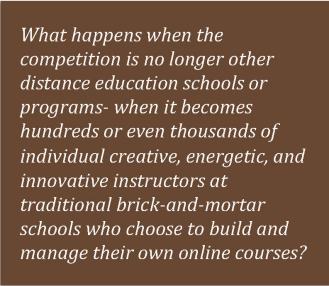 Last week there was another missive from Athabasca University interim president, Peter MacKinnon. The post appears to be damage control after a Metro article by Jeremey Nolais, Fears arise that Alberta’s Athabasca University will be lost as tough budget looms. The post says that while Athabasca is facing “financial challenges that are acute,” and “a decline in the rate of enrollment growth,” the rumors in the media that it will be merged with another school or shut down are untrue.
Last week there was another missive from Athabasca University interim president, Peter MacKinnon. The post appears to be damage control after a Metro article by Jeremey Nolais, Fears arise that Alberta’s Athabasca University will be lost as tough budget looms. The post says that while Athabasca is facing “financial challenges that are acute,” and “a decline in the rate of enrollment growth,” the rumors in the media that it will be merged with another school or shut down are untrue.
What I found interesting about the article were the comments. There are only 6 of them at this point, and three of the comments were complaints about insufficient interaction with tutors. They weren’t complaints about the call centre model, where students contact the call center and a call center employee determines whether an Academic Expert should be informed that the student needs assistance (contact ensuing within 2 business days). Instead they were complaints by students who had tutors but felt that they weren’t hearing from the tutors enough. As one student says, “… I did not pay to be completely ignored and paid to be TAUGHT.” [original emphasis]. There were complaints about the quality of education, and the blame for that laid at the feet of tutors as well.
Given the controversy surrounding the call center, and the seemingly obvious thing to comment about—that those who were unhappy with insufficient contact from their tutors could rest assured that they would soon have no contact with a tutor whatsoever—it is surprising that no comments of that nature were posted. After some experimentation, I determined that those points of view were being moderated out. The upshot is that readers will come away with the conclusion that what is wrong with Athabasca is its tutors, which is very convenient for the administration at present.
I’m not saying that all tutors do the job that students want them to; some tutors may not do the best job they can for any number of reasons, and some students may have bought into the misconception that they have a full-time teacher assigned to them.
But Athabasca’s problem isn’t tutors not doing what students want them to. Its problem is a structure designed in the days when distance education required sending students boxes of paper in the mail. This is a problem because the system that can most efficiently manage hard-copy course materials is one in which teachers cannot have the autonomy to alter their course materials at will to respond to students’ needs. Think of the nightmare that keeping track of document versions would be! There would be no control on the workflow (and therefore on costs) if instructors could alter materials whenever they found a better way to teach. In order for the school to function, teaching has to take a back seat to operations.
On the surface, it would seem that Athabasca has moved past this, with an online learning management system, online exams, and digital textbooks. At its core, however, Athabasca is still structured so that it is necessary to inhibit its teachers in order for it to operate as efficiently as possible. The reason I think that Athabasca’s problems are just beginning is that the costly and harmful structure they are fighting to protect is rapidly becoming unnecessary for distance education.
Think of it this way: these days most universities run courses through online learning management systems. Using these systems, instructors can post documents, set up quizzes and exams, post video links, post videos and podcasts of lectures, host class discussions, and more. It is entirely doable with a very minimal outlay for me to broadcast my in-class lectures live online, and have students answer questions in real time through Poll Everywhere while watching that lecture. We could discuss their answers as a group, and I could adjust my lecture on the fly to address issues that they were having. Students could even submit questions through Twitter during the lecture.
With courses set up this way, no-one sends students a box of paper course-materials. Students download and print what they want, access the rest online, and purchase textbooks directly from vendors in the format they want. Students can take a course and engage fully with a community of learners and an instructor without being in the classroom, whether that course is designated as distance education or not.
In contrast, Athabasca is structurally incapable of empowering its front-line teaching staff to act in their students’ best interest. It has people to grade papers and answer questions, but it doesn’t afford those people the mantle of “teacher,” the salary so they can be committed to students full-time, or the autonomy to fix issues with courses as they arise. Consider this: I don’t have access to the course materials that I wrote. If I want to fix a typo, there is a separate group of people who handle that sort of thing, and I have to make a request to get it done. I had to hunt around to find out who those people were. If I had the same control over my Athabasca courses as I do with some other courses I teach, I would just take the three seconds to fix the typo myself and not tie up IT people, and who knows who else. I would likely be updating the course regularly to improve it, which means that a separate expenditure on a Subject Matter Expert (who is also me) to revise the course every so many years would be unnecessary.
From a business perspective, it might have been safe at one time to compromise on teaching if you were the only game in town that could mail out those boxes of paper. But what happens when mailing out boxes of paper becomes irrelevant to serving students at a distance? What happens when the competition is no longer other distance education schools or programs, but hundreds or even thousands of individual creative, energetic, and innovative instructors at traditional brick-and-mortar schools who choose to build and manage their own online courses? What happens when the additional cost of running those courses is trivial, because the resources are already there as part of how on-site students are served? Well, what happens is that the competition is essentially crowd-sourced, and can do a better job with lower costs and happier teachers.
I don’t know what will become of Athabasca. As long as it offers programs that no-one else does there will be a demand for its product, and perhaps it will begin to focus on that segment of the market instead of a broad swath of undergraduate courses. But if it does offer programs that no-one else does, that will have more to do with no-one else choosing to offer those programs, rather than being unable to do so in a cost-effective manner. Athabasca will not change the way it operates because it is firmly committed to the notion that as long as the school is run as a business, the rest will take care of itself. The call centre model—where by design, the first person students talk to will never be the person teaching them—is evidence of that. There is an entrenched culture that holds front-line teachers in such low regard as to view answer databases and non-teaching call-center employees as a better alternative. This exists because at some level, Athabasca views itself as an organization for delivering courses rather than for teaching students.
